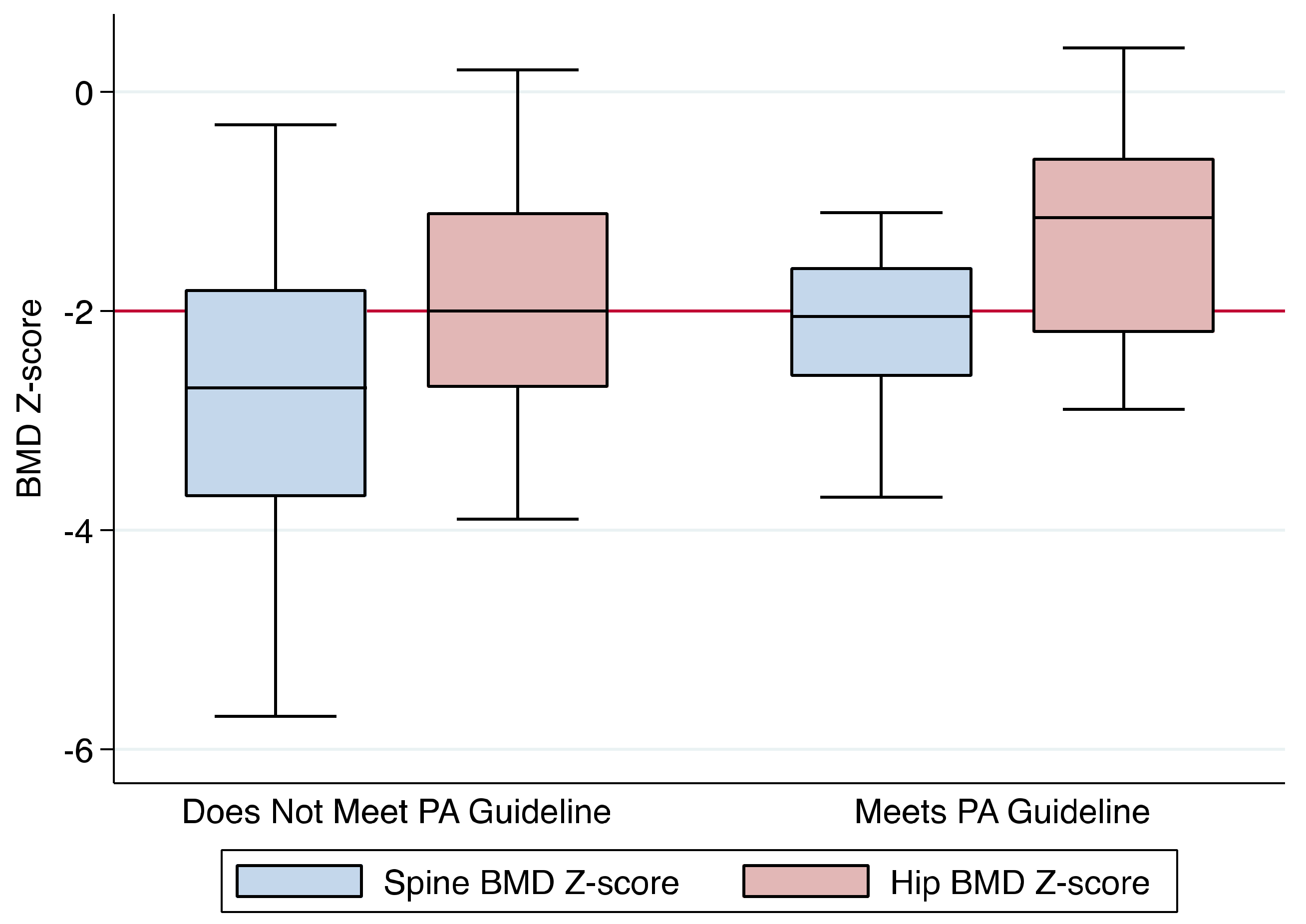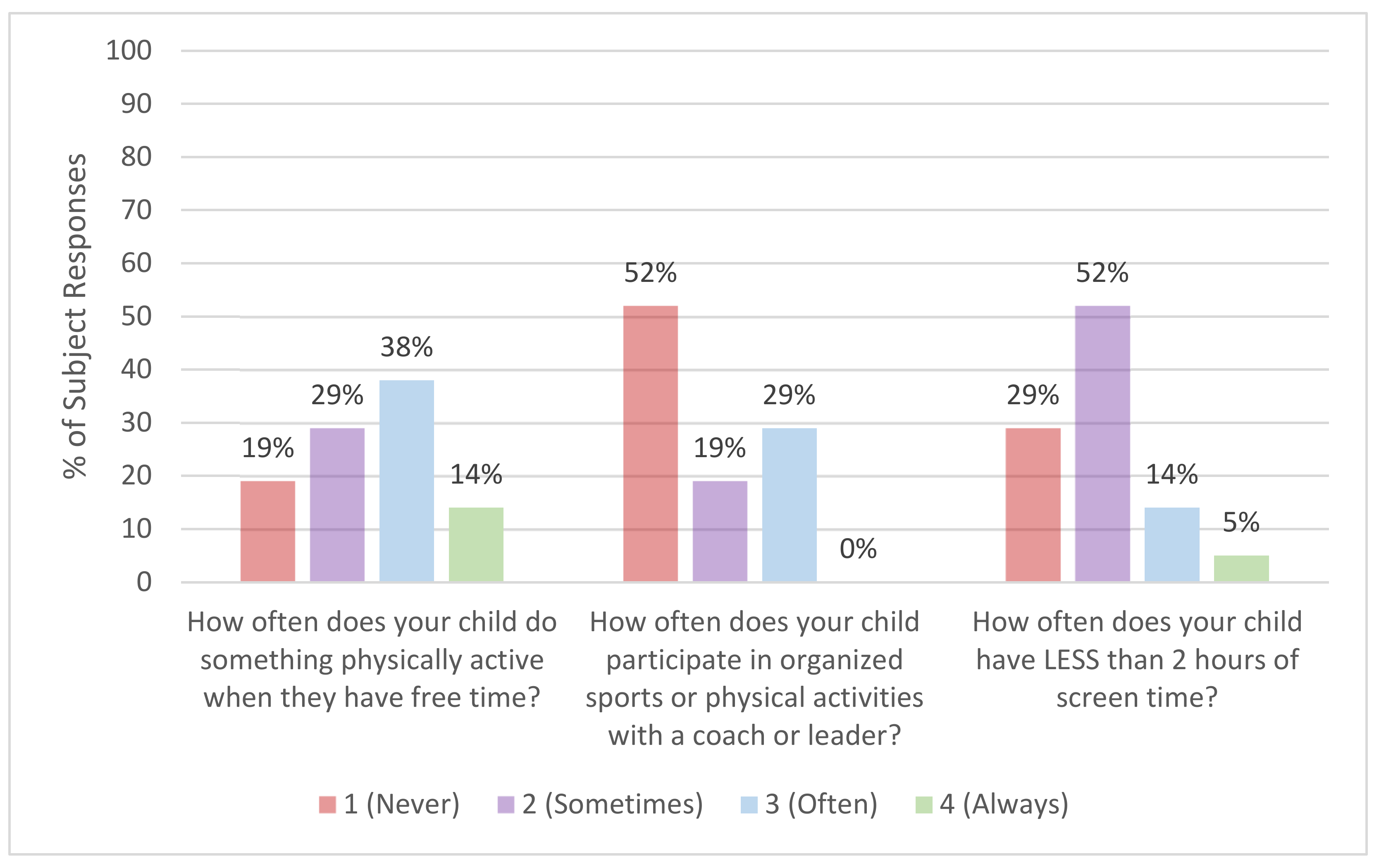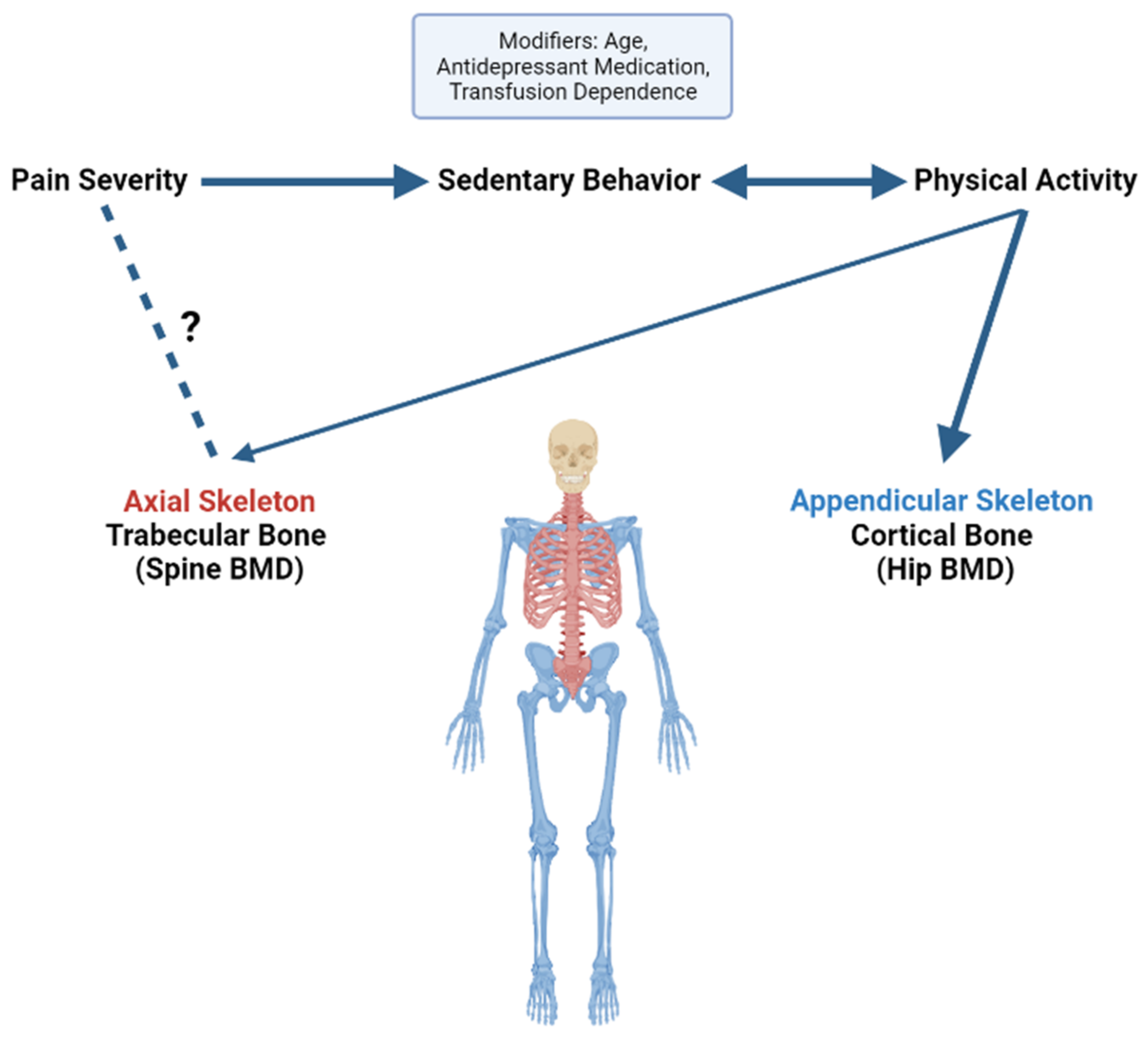Relationships among Physical Activity, Pain, and Bone Health in Youth and Adults with Thalassemia: An Observational Study
Abstract
1. Introduction
2. Materials and Methods
Statistics
3. Results
3.1. Bone Health
3.2. Pain
3.3. Activity
3.4. Healthy Behaviors in Youth
4. Discussion
Author Contributions
Funding
Institutional Review Board Statement
Informed Consent Statement
Conflicts of Interest
References
- Abetz, L.; Baladi, J.F.; Jones, P.; Rofail, D. The impact of iron overload and its treatment on quality of life: Results from a literature review. Health Qual. Life Outcomes 2006, 4, 73. [Google Scholar] [CrossRef] [PubMed]
- Wood, J.C.; Enriquez, C.; Ghugre, N.; Otto-Duessel, M.; Aguilar, M.; Nelson, M.D.; Moats, R.; Coates, T.D. Physiology and pathophysiology of iron cardiomyopathy in thalassemia. Ann. N. Y. Acad. Sci. 2005, 1054, 386–395. [Google Scholar] [CrossRef] [PubMed]
- Haines, D.; Martin, M.; Carson, S.; Oliveros, O.; Green, S.; Coates, T.; Eile, J.; Schilling, L.; Dinu, B.; Mendoza, T.; et al. Pain in thalassaemia: The effects of age on pain frequency and severity. Br. J. Haematol. 2013, 160, 680–687. [Google Scholar] [CrossRef] [PubMed]
- Oliveros, O.; Trachtenberg, F.; Haines, D.; Gerstenberger, E.; Martin, M.; Carson, S.; Green, S.; Calamaras, D.; Hess, P.; Yamashita, R.; et al. Pain over time and its effects on life in thalassemia. Am. J. Hematol. 2013, 88, 939–943. [Google Scholar] [CrossRef]
- Li, M.J.; Peng, S.S.; Lu, M.Y.; Chang, H.H.; Yang, Y.L.; Jou, S.T.; Lin, D.T.; Lin, K.H. Diabetes mellitus in patients with thalassemia major. Pediatr. Blood Cancer 2014, 61, 20–24. [Google Scholar] [CrossRef]
- Vogiatzi, M.G.; Macklin, E.A.; Fung, E.B.; Cheung, A.M.; Vichinsky, E.; Olivieri, N.; Kirby, M.; Kwiatkowski, J.L.; Cunningham, M.; Holm, I.A.; et al. Bone disease in thalassemia: A frequent and still unresolved problem. J. Bone Miner. Res. 2009, 24, 543–557. [Google Scholar] [CrossRef]
- Tubman, V.N.; Fung, E.B.; Vogiatzi, M.; Thompson, A.A.; Rogers, Z.R.; Neufeld, E.J.; Kwiatkowski, J.L.; Thalassemia Clinical Research Network. Guidelines for the Standard Monitoring of Patients With Thalassemia: Report of the Thalassemia Longitudinal Cohort. J. Pediatr. Hematol. Oncol. 2015, 37, e162–e169. [Google Scholar] [CrossRef] [PubMed]
- Fung, E.B.; Pinal, J.; Leason, M. Reduced Physical Activity Patterns in Patients with Thalassemia Compared to Healthy Controls. J. Hematol. Oncol. Res. 2015, 2, 7–21. [Google Scholar] [CrossRef]
- Nanas, S.; Vasileiadis, I.; Dimopoulos, S.; Sakellariou, D.; Kapsimalakou, S.; Papazachou, O.; Tasoulis, A.; Ladis, V.; Pangalis, G.; Aessopos, A. New insight into the exercise intolerance of beta-thalassemia major patients. Scand. J. Med. Sci. Sports 2009, 19, 96–102. [Google Scholar] [CrossRef]
- Piatti, G.; Giuditta, M.; Pierini, A.; Consonni, D.; Cassinerio, E.; Cappellini, M.D. Muscular de-conditioning and reduced cardiac inotropism due to iron deposition reduce exercise tolerance in beta thalassemia major. Am. J. Hematol. 2021, 96, E370–E373. [Google Scholar] [CrossRef]
- Sohn, E.Y.; Kato, R.; Noetzli, L.J.; Gera, A.; Coates, T.; Harmatz, P.; Keens, T.G.; Wood, J.C. Exercise performance in thalassemia major: Correlation with cardiac iron burden. Am. J. Hematol. 2013, 88, 193–197. [Google Scholar] [CrossRef] [PubMed]
- Mavrogeni, S.; Gotsis, E.; Verganelakis, D.; Berdousis, E.; Dritsas, A.; Kolovou, G.; Toulas, P.; Ladis, V. Effect of iron overload on exercise capacity in thalassemic patients with heart failure. Int. J. Cardiovasc. Imaging 2009, 25, 777–783. [Google Scholar] [CrossRef]
- Russo, C.R. The effects of exercise on bone. Basic concepts and implications for the prevention of fractures. Clin. Cases Miner. Bone Metab. 2009, 6, 223–228. [Google Scholar] [PubMed]
- Borer, K.T. The effects of exercise on growth. Sports Med. 1995, 20, 223–228. [Google Scholar] [CrossRef] [PubMed]
- Mirtz, T.A.; Chandler, J.P.; Eyers, C.M. The effects of physical activity on the epiphyseal growth plates: A review of literature on normal physiology and clinical implications. J. Clin. Med. Res. 2011, 3, 1–7. [Google Scholar] [CrossRef][Green Version]
- Van Dam, R.M.; Schuit, A.J.; Feskens, E.J.; Seidell, J.C.; Kromhout, D. Physical activity and glucose tolerance in elderly men: The Zutphen Elderly study. Med. Sci. Sports Exerc. 2002, 34, 1132–1136. [Google Scholar] [CrossRef] [PubMed]
- Ambrose, K.R.; Golightly, Y.M. Physical exercise as non-pharmacological treatment of chronic pain: Why and when. Best Pract. Res. Clin. Rheumatol. 2015, 29, 120–130. [Google Scholar] [CrossRef]
- Hamer, M.; Endrighi, R.; Poole, L. Physical activity, stress reduction, and mood: Insight into immunological mechanisms. Methods Mol. Biol. 2012, 934, 89–102. [Google Scholar]
- Álvarez-Bueno, C.; Pesce, C.; Cavero-Redondo, I.; Sánchez-López, M.; Garrido-Miguel, M.; Martínez-Vizcaíno, V. Academic Achievement and Physical Activity: A Meta-analysis. Pediatrics 2017, 140, e20171498. [Google Scholar] [CrossRef]
- Cleeland, C.S. The Brief Pain Inventory User Guide [Internet]. The University of Texas M. D. Anderson Cancer Center. 2009. Available online: http://dl.owneriq.net/b/bda4b416-56f9-4179-a75a-e102e933c0b1.pdf (accessed on 15 May 2022).
- Jumbo, S.U.; MacDermid, J.C.; Kalu, M.E.; Packham, T.L.; Athwal, G.S.; Faber, K.J. Measurement Properties of the Brief Pain Inventory-Short Form (BPI-SF) and Revised Short McGill Pain Questionnaire Version-2 (SF-MPQ-2) in Pain-related Musculoskeletal Conditions: A Systematic Review. Clin. J. Pain 2021, 37, 454–474. [Google Scholar] [CrossRef]
- Keller, S.; Bann, C.M.; Dodd, S.L.; Schein, J.; Mendoza, T.R.; Cleeland, C.S. Validity of the brief pain inventory for use in documenting the outcomes of patients with noncancer pain. Clin. J. Pain 2004, 20, 309–318. [Google Scholar] [CrossRef]
- Tan, G.; Jensen, M.P.; Thornby, J.I.; Shanti, B.F. Validation of the Brief Pain Inventory for chronic nonmalignant pain. J. Pain 2004, 5, 133–137. [Google Scholar] [CrossRef] [PubMed]
- Ihmels, M.A.; Welk, G.J.; Eisenmann, J.C.; Nusser, S.M. Development and preliminary validation of a Family Nutrition and Physical Activity (FNPA) screening tool. Int. J. Behav. Nutr. Phys. Act. 2009, 6, 14. [Google Scholar] [CrossRef] [PubMed]
- The Family Nutrition and Physical Activity Screening Tool! Available online: http://www.myfnpa.org/ (accessed on 15 May 2022).
- Rosenberg, D.E.; Norman, G.J.; Wagner, N.; Patrick, K.; Calfas, K.J.; Sallis, J.F. Reliability and validity of the Sedentary Behavior Questionnaire (SBQ) for adults. J. Phys. Act. Health 2010, 7, 697–705. [Google Scholar] [CrossRef] [PubMed]
- Meriwether, R.A.; McMahon, P.M.; Islam, N.; Steinmann, W.C. Physical activity assessment: Validation of a clinical assessment tool. Am. J. Prev. Med. 2006, 31, 484–491. [Google Scholar] [CrossRef]
- The International Society for Clinical Densitometry. 2019 ISCD Official Proceedings Adult. Available online: https://iscd.org/wp-content/uploads/2021/09/2019-Official-Positions-Adult-1.pdf (accessed on 31 May 2022).
- The International Society for Clinical Densitometry. 2019 ISCD Official Proceedings Pediatric. Available online: https://iscd.org/wp-content/uploads/2021/09/2019-Official-Positions-Pediatric-1.pdf (accessed on 31 May 2022).
- U.S Department of Health and Human Services. Physical Activity Guidelines for Americans, 2nd edition. Available online: https://health.gov/sites/default/files/2019-09/Physical_Activity_Guidelines_2nd_edition.pdf (accessed on 31 May 2022).
- Bailey-Davis, L.; Kling, S.M.R.; Wood, G.C.; Cochran, W.J.; Mowery, J.W.; Savage, J.S.; Stametz, R.A.; Welk, G.J. Feasibility of enhancing well-child visits with family nutrition and physical activity risk assessment on body mass index. Obes. Sci. Pract. 2019, 5, 220–230. [Google Scholar] [CrossRef]
- Trachtenberg, F.; Foote, D.; Martin, M.; Carson, S.; Coates, T.; Beams, O.; Vega, O.; Merelles-Pulcini, M.; Giardina, P.J.; Kleinert, D.A.; et al. Pain as an emergent issue in thalassemia. Am. J. Hematol. 2010, 85, 367–370. [Google Scholar] [CrossRef]
- Specker, B.; Thiex, N.W.; Sudhagoni, R.G. Does Exercise Influence Pediatric Bone? A Systematic Review. Clin. Orthop. Relat. Res. 2015, 473, 3658–3672. [Google Scholar] [CrossRef]
- Santos, L.; Elliott-Sale, K.J.; Sale, C. Exercise and bone health across the lifespan. Biogerontology 2017, 18, 931–946. [Google Scholar] [CrossRef]
- Green, S.T.; Martin, M.B.; Haines, D.; Carson, S.; Coates, T.; Oliveros, O.; Gerstenberger, E.; Trachtenberg, F.; Kwiatkowski, J.L. Variance of Pain Prevalence and associated severity during the transfusion cycle of adult thalassemia patients. Br. J. Haematol. 2014, 166, 797–800. [Google Scholar] [CrossRef]
- Arian, M.; Memarian, R.; Vakilian, F.; Badiee, Z. Impact of an 8-week walking program on quality of life in patients with thalassemia major. KAUMS J. (FEYZ) 2013, 17, 463–470. [Google Scholar]
- Hasanpour Dehkordi, A.; Hasani, T.; Fekri, K.; Deris, F.; Etemadifar, S. Effects of Aquatic Exercise on Dimensions of Quality of Life and Blood Indicators in Patients with Beta-Thalassemia Major. Int. J. Prev. Med. 2020, 11, 128. [Google Scholar] [CrossRef] [PubMed]



| Youth n = 21 | Adults n = 50 | Total n = 71 | p-Value 2 | |
|---|---|---|---|---|
| Age, years | 11.5 ± 3.6 1 (5.7–17.5) | 34.1 ± 9.4 (18.7–58.3) | 27.4 ± 13.2 | <0.001 |
| Male/female | 13/8 | 30/20 | 43/28 | NS |
| Thalassemia type, n | β-Thal, 12 E-ß Thal, 3 HbH or H/CS, 5 Other, 1 | β-Thal, 24 E-β Thal, 15 HbH or H/CS, 8 Other, 3 | β-Thal, 36 E-β Thal, 18 HbH or H/CS, 13 Other, 4 | NS |
| TDT, NTDT 3 | 71.4%, 28.6% | 86.0%, 14.0% | 81.7%, 18.3% | 0.15 |
| Body mass index, kg/m2 | 17.6 ± 3.1 | 22.2 ± 3.3 | 20.8 ± 3.8 | <0.001 |
| Overweight or obese 4 | 4.7% | 10% | 8.5% | NS |
| Current smoker 5 | 0 | 8.0% | 5.6% | NS |
| Former smoker | 0 | 6.0% | 4.2% | NS |
| Prescribed antidepressant medication | 0 | 12% | 6.5% | 0.11 |
| 25OH Vit D, ng/mL | 28.2 ± 10.9 | 38.8 ± 15.3 | 35.6 ± 14.9 | 0.008 |
| Low vitamin D 6 | 52.6% | 24.4% | 32.8% | 0.028 |
| TDT NTDT | 50% 50% | 63.6% 36.4% | 57.4% 42.8% | NS 7 |
| Spine BMD Z-score | −1.1 ± 0.7 | −2.5 ± 1.2 | −2.1 ± 1.2 | <0.001 |
| Hip BMD Z-score 8 | . | −1.7 ± 1.1 | . | |
| Whole body less head 8 BMD Z-score | −1.8 ± 0.5 | . | . | |
| Low bone mass 9 | 41.2% | 69.4% | 62.1% | 0.039 |
| TDT NTDT | 85.7% 14.3% | 88.2% 11.8% | 87.8% 12.2% | NS 10 |
| Youth n = 21 | Adults n = 50 | Total n = 71 | p-Value 1 | |
|---|---|---|---|---|
| Pain in past 24 h, count (% of cohort) | 6 (28.6) | 27 (54.0) | 33 (46.5) | 0.050 |
| Back pain, count (%) | 5 (23.8) | 22 (44.9) | 27 (38.6) | 0.097 |
| Pain in other body areas, count (%) | 6 (28.6) | 19 (38.8) | 25 (35.7) | NS |
| Any pain medication use, count (%) | 5 (23.8) | 23 (46.0) | 28 (39.4) | 0.08 |
| Average level of pain, 1–10 scale | 1.8 ± 2.3 | 2.6 ± 2.5 | 2.3 ± 2.4 | NS |
| Pain severity score 2 | 6.3 ± 7.8 | 7.8 ± 8.4 | 7.4 ± 8.2 | NS |
| Pain severity category 3 | Mild: 33% Moderate: 67% Severe: 0% | Mild: 59% Moderate: 30% Severe: 11% | Mild: 55% Moderate: 36% Severe: 9% | NS |
| Pain interference score 4 | 13.4 ± 16.0 | 13.6 ± 17.8 | 13.6 ± 17.2 | NS |
| Mean ± SD | Range | |
|---|---|---|
| Time spent in moderate physical activity for at least 10 min (days per week) | 3.2 ± 2.2 | 0–7 |
| Time spent in moderate physical activity (minutes per week) | 178 ± 211 | 0–870 |
| Time spent in vigorous physical activity (minutes per week) | 57 ± 91 | 0–300 |
| Average time spent in physical activity (moderate + vigorous, hours per day) | 0.5 ± 0.7 | 0–2.7 |
| Time spent in sedentary behaviors on weekdays (minutes) | 574 ± 266 | 80–1170 |
| Time spent in sedentary behaviors on weekends (minutes) | 521 ± 278 | 60–1260 |
| Average time spent in sedentary behaviors (hours per day) | 2.6 ± 1.2 | 0.6–5.4 |
Publisher’s Note: MDPI stays neutral with regard to jurisdictional claims in published maps and institutional affiliations. |
© 2022 by the authors. Licensee MDPI, Basel, Switzerland. This article is an open access article distributed under the terms and conditions of the Creative Commons Attribution (CC BY) license (https://creativecommons.org/licenses/by/4.0/).
Share and Cite
Fung, E.B.; Goldberg, E.K.; Bambot, S.; Manzo, R.; Lal, A. Relationships among Physical Activity, Pain, and Bone Health in Youth and Adults with Thalassemia: An Observational Study. Thalass. Rep. 2022, 12, 90-100. https://doi.org/10.3390/thalassrep12030014
Fung EB, Goldberg EK, Bambot S, Manzo R, Lal A. Relationships among Physical Activity, Pain, and Bone Health in Youth and Adults with Thalassemia: An Observational Study. Thalassemia Reports. 2022; 12(3):90-100. https://doi.org/10.3390/thalassrep12030014
Chicago/Turabian StyleFung, Ellen B., Elijah K. Goldberg, Sakina Bambot, Raquel Manzo, and Ashutosh Lal. 2022. "Relationships among Physical Activity, Pain, and Bone Health in Youth and Adults with Thalassemia: An Observational Study" Thalassemia Reports 12, no. 3: 90-100. https://doi.org/10.3390/thalassrep12030014
APA StyleFung, E. B., Goldberg, E. K., Bambot, S., Manzo, R., & Lal, A. (2022). Relationships among Physical Activity, Pain, and Bone Health in Youth and Adults with Thalassemia: An Observational Study. Thalassemia Reports, 12(3), 90-100. https://doi.org/10.3390/thalassrep12030014






